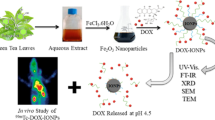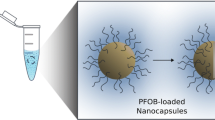Abstract
Barium sulfate (BaSO4) nanoparticles (<100 nm) are of interest to provide improved performance over microscale BaSO4 particles, which are currently used clinically as an X-ray contrast agent or radiopacifier, and to further enable passive or targeted delivery of BaSO4 contrast agents. The stability of BaSO4 nanoparticle dispersions in aqueous media is critical for these uses but has received little attention. Therefore, the objective of this study was to prepare and characterize a BaSO4 nanoparticle contrast agent with colloidal stability in aqueous media. Monodisperse BaSO4 nanoparticles, ~13 nm in diameter, were synthesized using water-in-oil nanoemulsions wherein the aqueous droplet size limited particle growth and the surfactant layer provided a barrier against aggregation. The as-synthesized nanoparticles were readily redispersed in organic solvents but agglomerated when redispersed in aqueous media due to exhibiting a low, nearly isoelectric zeta potential at neutral pH. Therefore, the as-synthesized BaSO4 nanoparticles were subsequently encapsulated by crosslinked dextran within the nanoemulsion droplets in order to provide both steric and electrostatic stabilization upon breaking the nanoemulsion. Dextran encapsulation increased the particle diameter to ~40 nm, but enabled BaSO4 nanoparticles to be readily redispersed in water and maintain colloidal stability for more than a month. The X-ray attenuation of dispersed dextran-encapsulated BaSO4 nanoparticles was not different from that measured for either a commercial microscale BaSO4 suspension or a solution of barium ions prepared in water at an equal mass concentration of barium, but was significantly greater than the attenuation exhibited by soft tissues. Thus, dextran-encapsulated BaSO4 nanoparticles appear to be suitable for passive or targeted delivery as an X-ray contrast agent.
Graphical Abstract







Similar content being viewed by others
References
Albanase A, Tang PS, Chan WCW (2012) The effect of nanoparticle size, shape, and surface chemistry on biological systems. Annu Rev Biomed Eng 14:1–16
Bala H, Fu W, Zhao J, Ding X, Jiang Y, Yu K, Wang Z (2005) Preparation of BaSO4 nanoparticles with self-dispersing properties. Colloids Surf A 252:129–134
Balastre M, Argillier JF, Allain C, Foissy A (2002) Role of polyelectrolyte dispersant in the settling behaviour of barium sulphate suspension. Colloids Surf A 211:145–156
Berger MJ, Hubbell JH, Seltzer SM, Chang J, Coursey JS, Sukumar R, Zucker DS, Olsen K (2010) XCOM: Photon Cross Section Database. National Institute of Standards and Technology: Gaithersburg, MD. http://physics.nist.gov/xcom. Accessed 22 Sep 2013
Boisselier E, Astruc D (2009) Gold nanoparticles in nanomedicine: preparations, imaging, diagnostics, therapies and toxicity. Chem Soc Rev 38:1759–1782
Cai QY, Kim SH, Choi KS, Kim SY, Byun SJ, Kim KW, Park SH, Juhng SK, Yoon K-H (2007) Colloidal gold nanoparticles as a blood-pool contrast agent for X-ray computed tomography in mice. Invest Radiol 42(12):797–806
Chanda N, Kattumuri V, Shukla R, Zambre A, Katti K, Upendran A, Kulkami RR, Kan P, Fent GM, Casteel SW, Smith CJ, Boote E, Robertson JD, Cutler C, Lever JR, Katti KV, Kannan R (2010) Bombesin functionalized gold nanoparticles show in vitro and in vivo cancer receptor specificity. Proc Natl Acad Sci 107(10):8760–8765
Cullity B (1978) Elements of X-ray diffraction. Addison-Wesley Publishing Company Inc, Reading, MA, pp 281–285
De M, Ghosh PS, Rotello VM (2008) Applications of nanoparticles in biology. Adv Mater 20(22):4225–4241
Eastoe J, Dalton JS (2000) Dynamic surface tension and adsorption mechanisms of surfactants at the air-water interface. Adv Colloid Interface Sci 85:103–144
Galper MW, Saung MT, Fuster V, Roessl E, Thran A, Proksa R, Fayad ZA, Cormode DP (2012) Effect of computed tomography scanning parameters on gold nanoparticle and iodine contrast. Invest Radiol 47(8):475–481
Gaumet M, Vargas A, Gurny R, Delie F (2008) Nanoparticles for drug delivery: the need for precision in reporting particle size parameters. Eur J Pharm Biopharm 69:1–9
Gelfand DW, Ott DJ (1982) Barium sulfate suspensions: an evaluation of available products. Am J Roentgenol 138(5):935–941
Gillani R, Ercan B, Qiao A, Webster TJ (2010) Nanofunctionalized zirconia and barium sulfate particles as bone cement additives. Int J Nanomed 5(1):1–11
Gomoll AH, Fitz W, Scott RD, Thornhill TS, Bellare A (2008) Nanoparticulate fillers improve the mechanical strength of bone cement. Acta Orthop 79:421–427
Hainfeld JF, Slatkin DN, Focella TM, Smilowitz HM (2006) Gold nanoparticles: a new X-ray contrast agent. Brit J Radiol 79(939):248–253
Hainfeld JF, O’Connor MJ, Bilmanian FA, Slatkin DN, Adams DJ, Smilowitz HM (2011) Micro-CT enables microlocalisation and quantification of Her2-targeted gold nanoparticles within tumour regions. Brit J Radiol 84(1002):526–533
Hang JZ, Zhang YF, Shi LY, Feng X (2007) Electrokinetic properties of barite nanoparticles suspensions in different electrolyte media. J Mater Sci 42:9611–9616
Hopwood JD, Mann S (1997) Synthesis of barium sulfate nanoparticles and nanofilaments in reverse micelles and microemulsions. Chem Mater 9:1819–1828
Hubbell JH (1969) Photon cross sections, attenuation coefficients, and energy absorption coefficients from 10 keV to 100 GeV. Nat Stand Ref Data Ser 29:85
Hubbell JH, Seltzer SM (2004) Table of X-ray Mass Attenuation Coefficients and Mass Energy-Absorption Coefficients (version 1.4). National Institute of Standards and Technology, Gaithersburg, MD. Available at: http://physics.nist.gov/xaamdi. Accessed 22 Sep 2013
Hubbell JH, Gimm HA, Overbo I (1980) Pair, triplet, and total atomic cross sections (and mass attenuation coefficients) for 1 MeV–100 GeV photons in elements Z = 1 to 100. J Phys Chem Ref Data 9:1023–1147
Ivanova NI, Rudelev DS, Summ BD, Chalykh AA (2001) Synthesis of barium sulfate nanoparticles in water-in-oil microemulsion systems. Colloid J 63(6):714–717
JCPDS (1997), Powder Diffraction File 24-1035, BaSO4, Barium Sulfate. JCPDS—International Center for Diffraction Data (ICDD), Newton Square, PA
Kim S-H, Won C-Y, Chu C-C (1999) Synthesis and characterization of dextran-maleic acid based hydrogel. J Biomed Mater Res 46:160–170
Knothe-Tate ML, Niederer P, Knothe U (1998) In vivo tracer transport though the lacunocanalicular system of rat bone in an environment devoid of mechanical loading. Bone 22(2):107–117
Koetz J, Bahnemann J, Lucas G, Tiersch B, Kosmella S (2004) Polyelectrolyte-modified microemulsions as new templates for the formation of nanoparticles. Colloids Surf A 250:423–430
Lam AC, Falk NA, Schechter RS (1987) The thermodynamics of microemulsions. J Colloid Interface Sci 120:30–41
Landrigan MD, Flatley JC, Turnbull TL, Kruzic JJ, Ferracane JL, Hilton TJ, Roeder RK (2010) Detection of dentinal cracks using contrast enhanced micro-computed tomography. J Mech Behav Biomed Mater 3(2):223–227
Landrigan MD, Li J, Turnbull TL, Burr DB, Niebur GL, Roeder RK (2011) Contrast-enhanced micro-computed tomography of fatigue microdamage accumulation in human cortical bone. Bone 48(3):443–450
Leng H, Wang X, Niebur GL, Roeder RK (2004) Synthesis of a barium sulfate nanoparticle contrast agent for micro-computed tomography of bone microstructure. Ceram Trans 159:219–229
Lewis G (1997) Properties of acrylic bone cement: state of the art review. J Biomed Mater Res (Appl Biomater) 38B:155–182
Li S, Xu J, Luo G (2007) Control of crystal morphology through supersaturation ratio and mixing conditions. J Crystal Growth 304:219–224
Niemann B, Veit P, Sundmacher K (2008) Nanoparticle precipitation in reverse microemulsions: particle formation dynamics and tailoring of particle size distributions. Langmuir 24:4320–4328
O’Connor SD, Summers RM (2007) Revisiting oral barium sulfate contrast agents. Acad Radiol 14:72–80
Özdemir C, Çolak N, Güner A (2007) Solution dynamics of the dextran/crosslinking agent systems. J Appl Polym Sci 105:1177–1187
Palmacci S, Josephson L (1993) Synthesis of polysaccharide covered superparamagnetic oxide colloids. U.S. Patent No. 5 262 176
Popovtzer R, Agrawal A, Kotov NA, Popovtzer A, Balter J, Carey TE, Kopelman R (2008) Targeted gold nanoparticle enable molecular CT imaging of cancer. Nano Lett 8(12):4593–4596
Qi L, Ma J, Cheng H, Zhao Z (1996) Preparation of BaSO4 nanoparticles in non-ionic w/o microemulsions. Colloids Surf A 108:117–126
Ricker A, Liu-Snyder P, Webster TJ (2008) The influence of nano MgO and BaSO4 particle size additives on properties of PMMA bone cement. Int J Nanomed 3(1):125–132
Riddick TM (1968) Control of Colloid Stability Through Zeta Potential. Zeta Meter Inc., New York, NY
Ross RD, Cole LE, Roeder RK (2012) Relative binding affinity of carboxylate-, phosphonate-, and bisphosphonate-functionalized gold nanoparticles targeted to damaged bone tissue. J Nanopart Res 14(10):1175 (6 pages)
Ross RD, Cole LE. Tilley JMR, Roeder RK (2013) Effects of functionalized gold nanoparticle size on X-ray attenuation and binding affinity to hydroxyapatite. Chem Mater, in review
Skucas J (1989) Radiographic contrast agents. Aspen Publishers Inc., Rockville, MD, pp 10–76
Tassa C, Shaw ST, Weissleder R (2011) Dextran-coated iron oxide nanoparticles: a versatile platform for targeted molecular imaging, molecular diagnostics and therapy. Acc Chem Res 44:842–852
Thorek DLJ, Chen AK, Czupryna J, Tsourkas A (2006) Superparamagnetic iron oxide nanoparticle probes for molecular imaging. Ann Biomed Eng 34:23–28
Turnbull TL, Gargac JA, Niebur GL, Roeder RK (2011) Detection of fatigue microdamage in whole rat femora using contrast-enhanced micro-computed tomography. J Biomech 44:2395–2400
Uchida M, Sue A, Yoshioka T, Okuwaki A (2001) Morphology of barium sulfate synthesized with barium(ii)-aminocarboxylate precursors. CrystEngComm 5:1–6
Williamson GK, Hall WH (1953) X-ray line broadening from filed aluminium and wolfram. Acta Metall 1:22–31
Wu L, Zhang J, Watanabe W (2011) Physical and chemical stability of drug nanoparticles. Adv Drug Delivery Rev 63:456–469
Xu C, Tung GA, Sun S (2008) Size and concentration effect of gold nanoparticles on X-ray attenuation as measured on computed tomography. Chem Mater 20(13):4167–4169
Yu S-B, Watson AD (1999) Metal-based X-ray contrast media. Chem Rev 99:2353–2377
Acknowledgments
This research was supported by the U.S. Army Medical Research and Materiel Command (W81XWH-06-1-0196) through the Peer Reviewed Medical Research Program (PR054672). The authors acknowledge the Notre Dame Integrated Imaging Facility (NDIIF) for the use of TEM and SEM.
Author information
Authors and Affiliations
Corresponding author
Rights and permissions
About this article
Cite this article
Meagher, M.J., Leone, B., Turnbull, T.L. et al. Dextran-encapsulated barium sulfate nanoparticles prepared for aqueous dispersion as an X-ray contrast agent. J Nanopart Res 15, 2146 (2013). https://doi.org/10.1007/s11051-013-2146-8
Received:
Accepted:
Published:
DOI: https://doi.org/10.1007/s11051-013-2146-8




